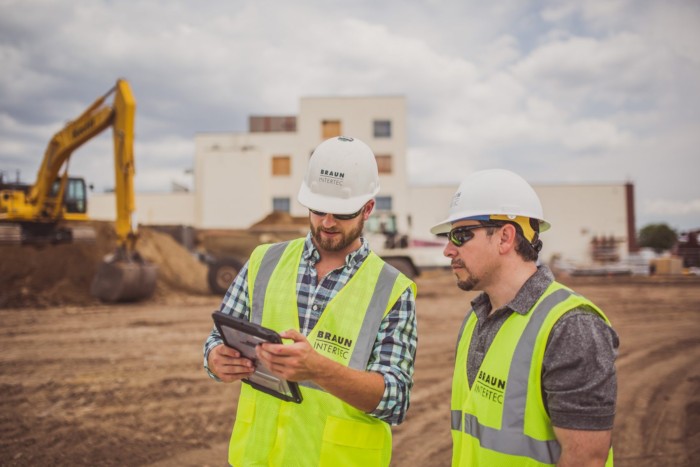The Geotheta Statements
Wiki Article
Facts About Geotheta Uncovered
Table of ContentsGeotheta Fundamentals ExplainedNot known Details About Geotheta What Does Geotheta Mean?Some Known Factual Statements About Geotheta Geotheta Fundamentals Explained

They carry out website investigations, gather examples, execute lab tests, and assess data to examine the viability of the ground for construction tasks - Consulting Engineer. Based on their searchings for, geotechnical designers give recommendations for foundation design, slope stability, keeping structures, and mitigation of geotechnical threats. They collaborate with other professionals, such as engineers, structural engineers, and building and construction teams, to ensure that geotechnical considerations are incorporated right into the total job style and application
By examining the actions and buildings of soil and rock, they can recognize prospective geotechnical dangers such as landslides, soil negotiation, or incline instability. Their know-how assists stop failings or crashes that might jeopardize lives and residential or commercial property. Here are some in-depth tasks and obligations of a geotechnical designer: Site Investigation: Geotechnical engineers conduct site examinations to collect data on subsurface conditions.
They translate the data to comprehend the residential or commercial properties and habits of the dirt and rock, including their stamina, permeability, compaction qualities, and groundwater conditions. Geotechnical Evaluation and Design: Geotechnical designers assess the information accumulated during site examinations to assess the security and viability of the site for construction projects. They perform geotechnical computations and modeling to review elements such as birthing ability, settlement, incline security, side earth pressures, and groundwater circulation.
Excitement About Geotheta
Foundation Design: Geotechnical engineers play an essential role in designing structures that can safely support the designated framework. They evaluate the soil conditions and tons needs to determine the suitable structure type, such as superficial foundations (e.g., footings), deep foundations (e.g (https://geotheta.jimdosite.com/)., heaps), or specialized strategies like soil renovation. They take into consideration elements such as settlement restrictions, bearing capacity, and soil-structure interaction to create optimal structure designsThey assess building and construction strategies, display site activities, and carry out field evaluations to confirm that the layout suggestions are complied with. If unexpected geotechnical issues develop, they analyze the situation and provide referrals for removal or changes to the design. Risk Analysis and Reduction: Geotechnical engineers analyze geotechnical threats and dangers related to the task website, such as landslides, liquefaction, or dirt disintegration.

Cooperation and Interaction: Geotechnical engineers work very closely with other professionals entailed in a job, such as designers, structural designers, and construction groups. Reliable communication and partnership are necessary visit this page to integrate geotechnical factors to consider into the total project layout and building process. Geotechnical designers offer technological know-how, answer queries, and guarantee that geotechnical needs are satisfied.
The Best Strategy To Use For Geotheta
Below are some kinds of geotechnical designers: Structure Designer: Structure designers specialize in developing and assessing foundations for structures. They examine the dirt conditions, tons demands, and website features to establish the most ideal foundation type and style, such as superficial structures, deep structures, or specialized techniques like stack structures.They examine the aspects affecting slope stability, such as soil residential properties, groundwater problems, and slope geometry, and create approaches to stop incline failings and minimize threats. Quake Designer: Earthquake designers focus on examining and creating structures to endure seismic forces. They evaluate the seismic risk of a website, examine soil liquefaction capacity, and develop seismic layout standards to make sure the security and durability of frameworks during earthquakes.
They do area screening, gather samples, and analyze the gathered information to define the soil properties, geologic formations, and groundwater conditions at a site. Geotechnical Instrumentation Designer: Geotechnical instrumentation engineers concentrate on monitoring and gauging the actions of dirt, rock, and structures. They install and keep instrumentation systems that keep an eye on aspects such as dirt settlement, groundwater degrees, slope movements, and architectural variations to examine performance and give early cautions of prospective problems.
Facts About Geotheta Uncovered
They perform tests such as triaxial examinations, debt consolidation examinations, straight shear tests, and permeability examinations to gather data for geotechnical evaluation and layout. Geosynthetics Engineer: Geosynthetics engineers focus on the layout and application of geosynthetic materials, such as geotextiles, geogrids, and geomembranes. They utilize these materials to boost soil stability, strengthen inclines, give drainage options, and control disintegration.They often tend to be investigative individuals, which suggests they're intellectual, reflective, and analytical. They wonder, systematic, sensible, logical, and logical. Several of them are additionally social, implying they're kind, generous, participating, person, caring, useful, compassionate, skillful, and pleasant. Does this seem like you? Take our totally free occupation examination to figure out if geotechnical designer is among your top job matches.
In the workplace setting, geotechnical designers use specialized software application tools to perform calculations, develop styles, and evaluate data. They prepare reports, review task specifications, communicate with customers and group members, and coordinate project tasks. The office setting gives a conducive setting for research study, analysis, and collaboration with other professionals involved in the task.
Our Geotheta Ideas
They regularly go to task sites to perform site examinations, analyze geotechnical problems, and collect information for evaluation. These sees involve traveling to various locations, in some cases in remote or tough terrains. Geotechnical engineers might perform soil sampling, conduct examinations, and monitor building and construction activities to make certain that the geotechnical facets of the job are being implemented appropriately.Geotechnical designers likewise function in specialized geotechnical labs. Geotechnical laboratory designers function thoroughly in these settings, taking care of screening tools, running instruments, and taping information.
Report this wiki page